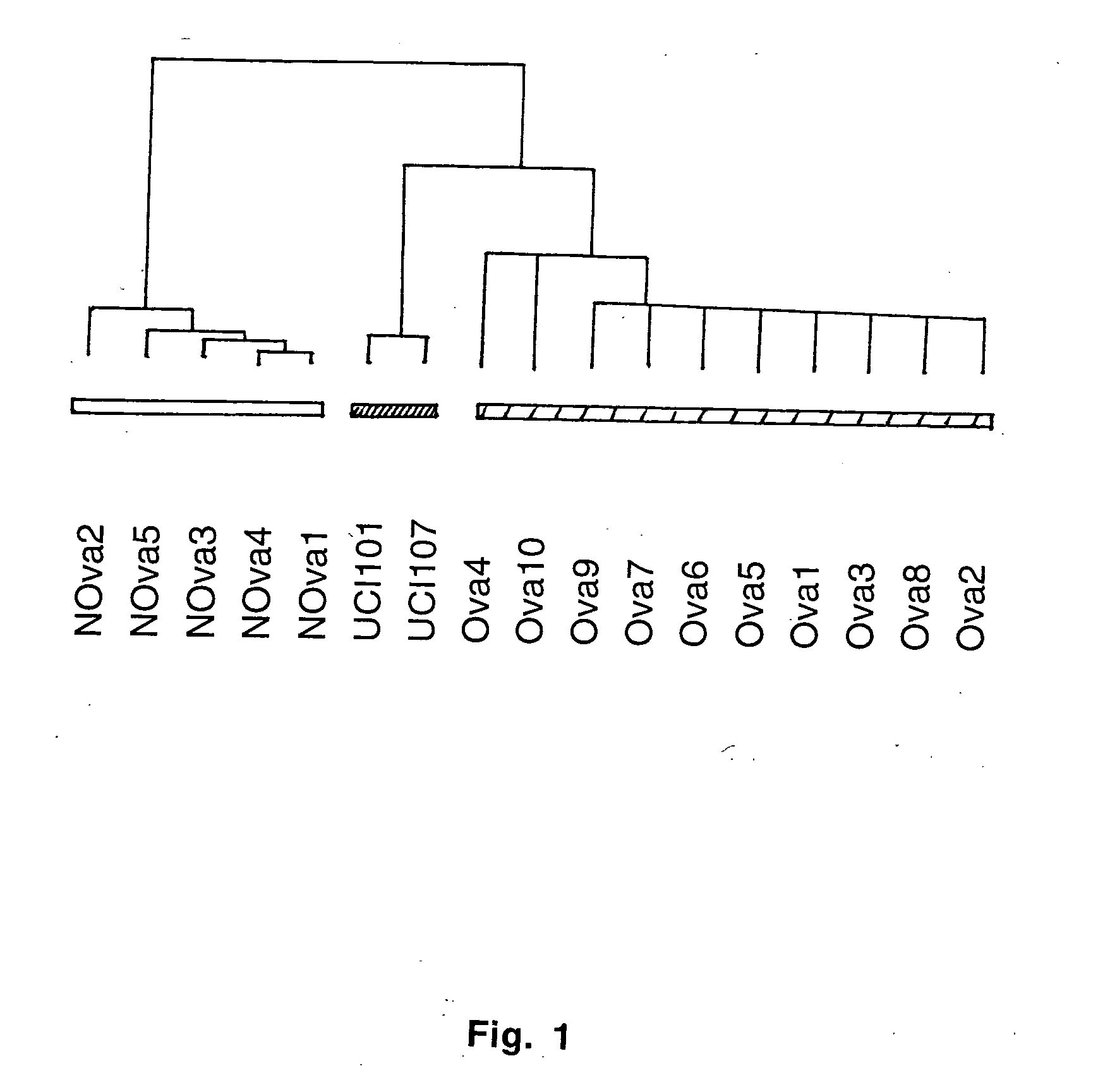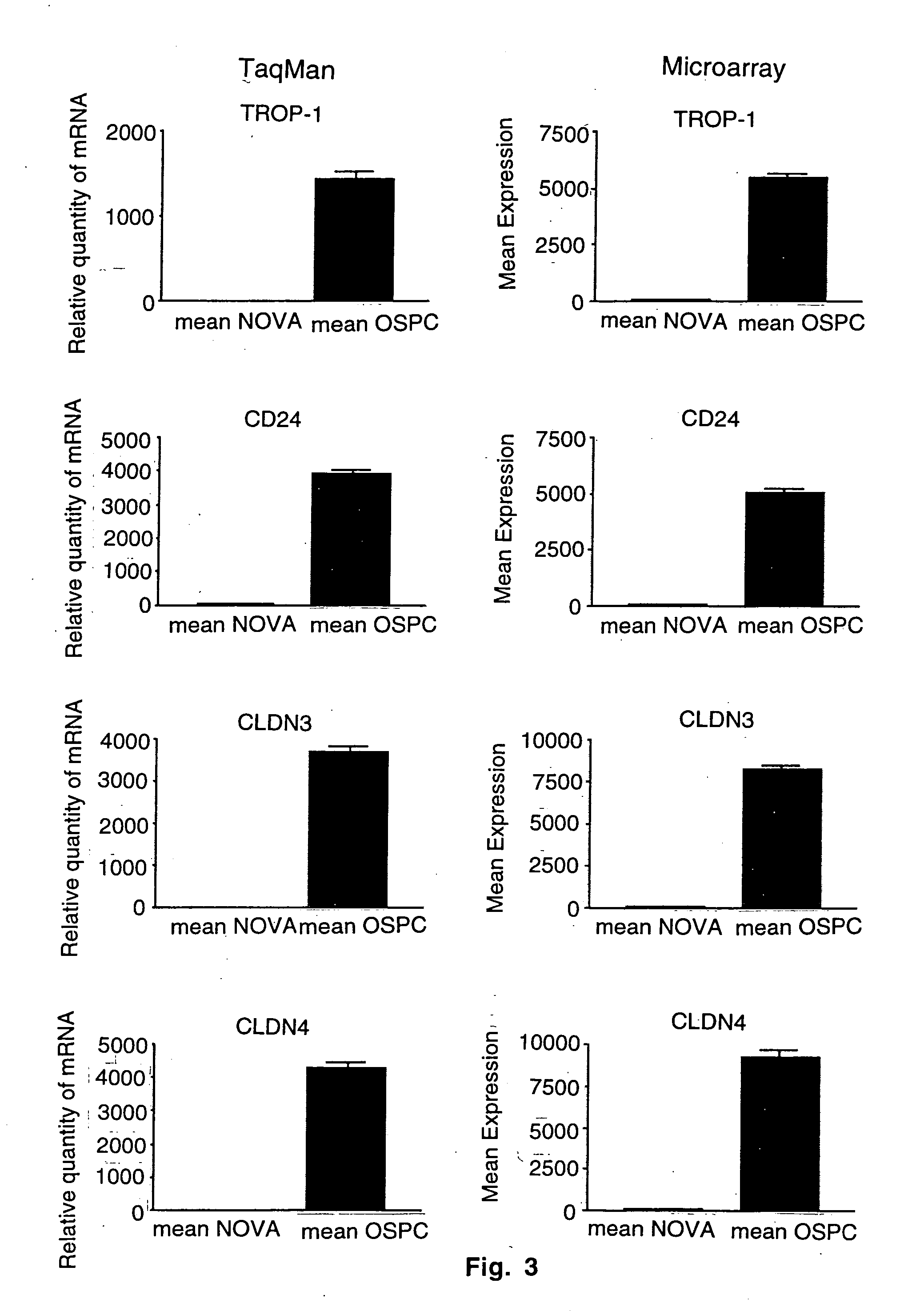Gene expression profiling in primary ovarian serous papillary tumors and normal ovarian epithelium
a gene expression and primary ovarian cancer technology, applied in the field of cancer research, can solve the problems of ovaries remaining the most lethal gynecologic malignancies, affecting the ovaries, and unable to fully understand the molecular differences between ovaries, so as to achieve the effect of high-leveling the divergence of gene expression
- Summary
- Abstract
- Description
- Claims
- Application Information
AI Technical Summary
Benefits of technology
Problems solved by technology
Method used
Image
Examples
example 1
Establishment of Primary Ovarian Serous Papillary Carcinoma And Normal Ovarian Epithelial Cell Lines
[0045] A total of 15 primary cell lines (i.e., 10 ovarian serous papillary carcinomas cell lines and 5 normal ovarian epithelial cell lines) were established after sterile processing of the tumor samples from surgical biopsies as previously described for ovarian carcinoma specimens (Ismail et al., 2000; Hough et al., 2000; Santin et al., 2000). UCI-101 and UCI-107, two previously characterized ovarian serous papillary carcinomas cell lines (Fuchtner et al., 1993; Gamboa et al., 1995) were also included in the analysis. Tumors were staged according to the F.I.G.O. operative staging system. Radical tumor debulking, including a total abdominal hysterectomy and omentectomy, was performed in all ovarian carcinoma patients while normal ovarian tissue was obtained from consenting donors who undergo surgery for benign pathology scraping epithelial cells from the ovarian surface. No patient r...
example 2
Microarray Hybridization And Statistical Analysis
[0048] RNA purification, cDNA synthesis, cRNA preparation, and hybridization to the Affymetrix Human U95Av2 GeneChip microarray were performed according to the manufacturer's protocols and as reported (Zhan et al., 2002). All data used in the analyses were derived from Affymetrix 5.0 software. GeneChip 5.0 output files are given as a signal that represents the difference between the intensities of the sequence-specific perfect match probe set and the mismatch probe set, or as a detection of present, marginal, or absent signals as determined by the GeneChip 5.0 algorithm. Gene arrays were scaled to an average signal of 1500 and then analyzed independently. Signal calls were transformed by the log base 2 and each sample was normalized to give a mean of 0 and variance of 1.
[0049] Statistical analyses of the data were performed with the software packages SPSS10.0 (SPSS, Chicago, Ill.) and the significance analysis of microarrays (SAM) m...
example 3
Gene Expression Profiles Distinguish Ovarian Serous Papillary Carcinoma Cells from Normal Ovarian Epithelial Cells And Identify Differentially Expressed Genes
[0051] Flash frozen biopsies from ovarian tumor tissue are known to contain significant numbers of contaminant stromal cells as well as a variety of host derived immune cells (e.g., monocytes, dendritic cells, lymphocytes). In addition, because ovarian epithelial cells represent a small proportion of the total cells found in the normal ovary, it is difficult to collect primary material that is free of contaminating ovarian stromal cells in sufficient quantities to conduct comparative gene expression analyses. Ovarian epithelial cells, however, can be isolated and expanded in culture for about 15 passages (Ismail et al., 2000) while the majority of primary ovarian carcinomas can be expanded in vitro for at least a few weeks. Thus, short term primary ovarian serous papillary carcinomas and normal ovarian epithelial cell cultures...
PUM
| Property | Measurement | Unit |
|---|---|---|
| total volume | aaaaa | aaaaa |
| total volume | aaaaa | aaaaa |
| volume | aaaaa | aaaaa |
Abstract
Description
Claims
Application Information
 Login to View More
Login to View More - R&D
- Intellectual Property
- Life Sciences
- Materials
- Tech Scout
- Unparalleled Data Quality
- Higher Quality Content
- 60% Fewer Hallucinations
Browse by: Latest US Patents, China's latest patents, Technical Efficacy Thesaurus, Application Domain, Technology Topic, Popular Technical Reports.
© 2025 PatSnap. All rights reserved.Legal|Privacy policy|Modern Slavery Act Transparency Statement|Sitemap|About US| Contact US: help@patsnap.com



